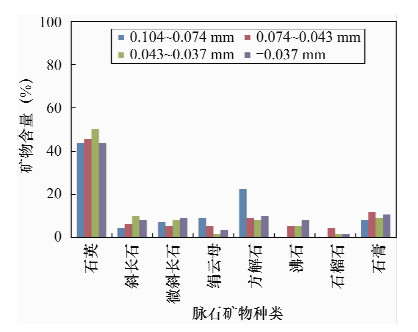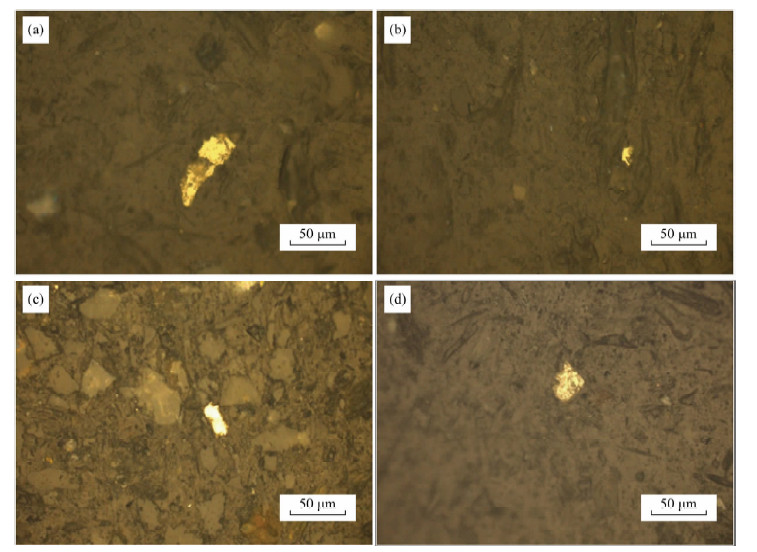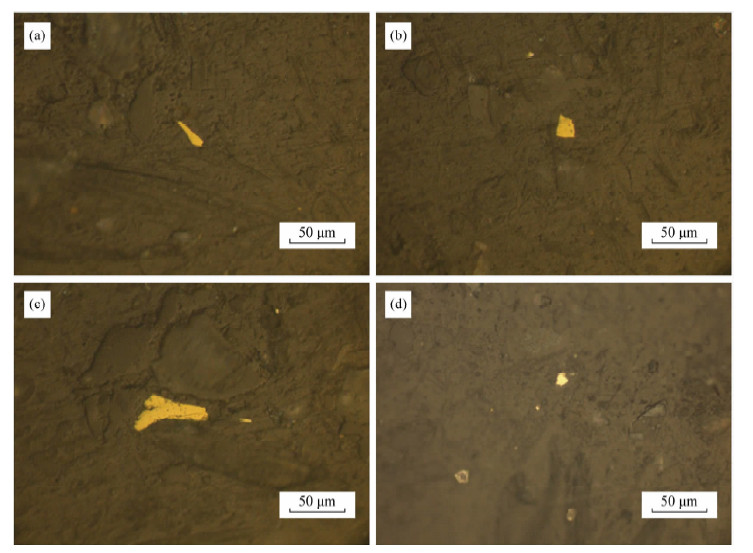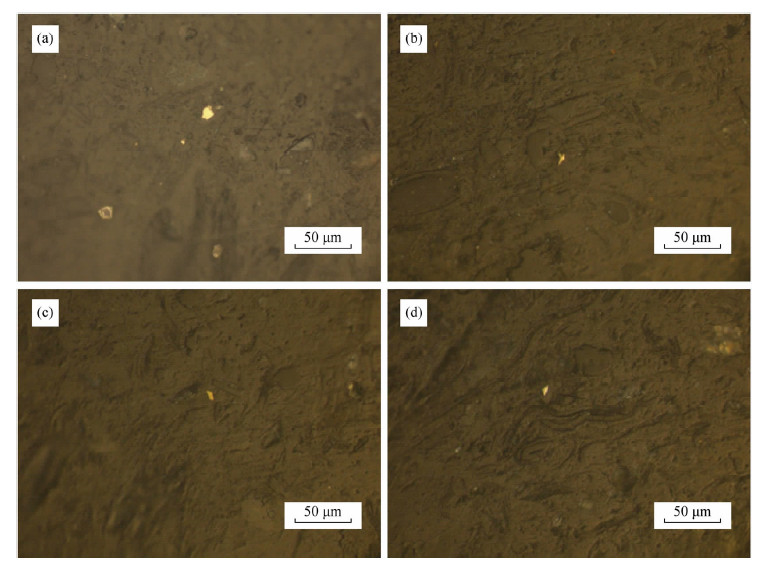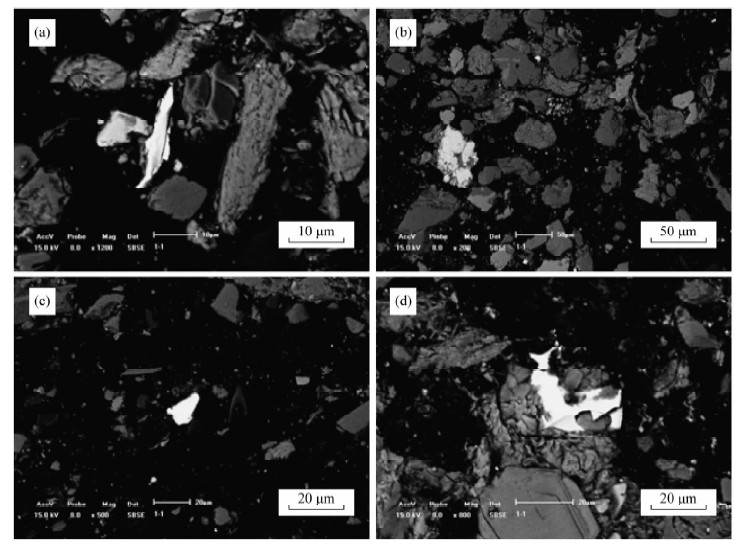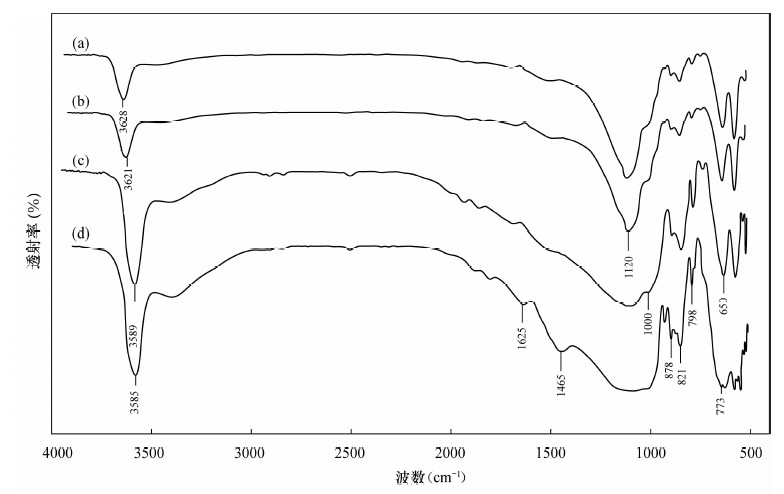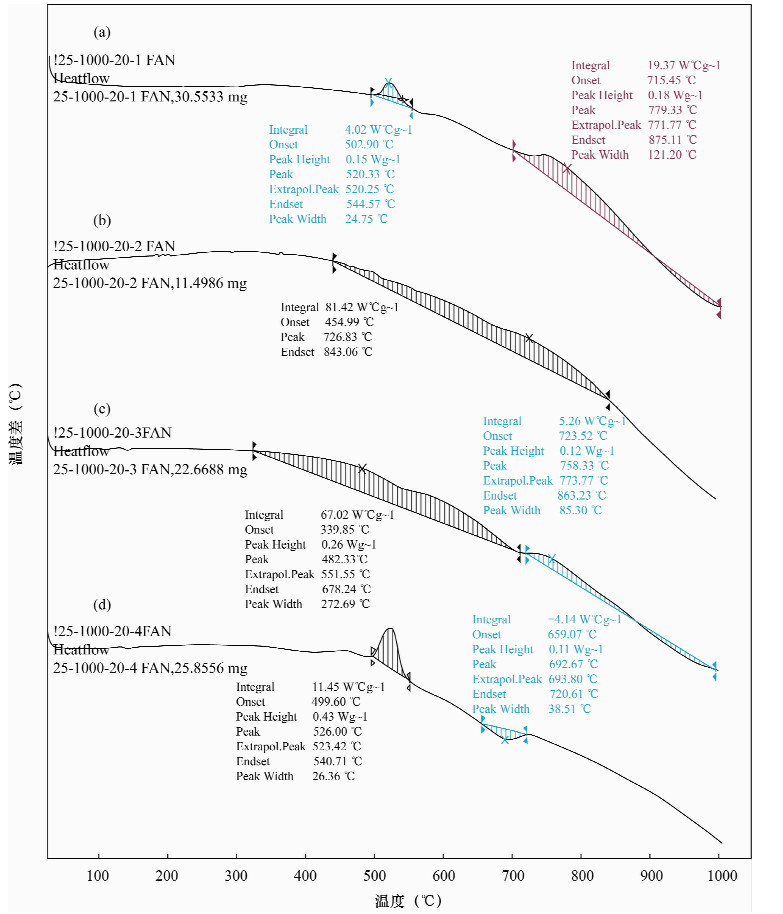The Mineralogy Characteristics of Overflow Product from Hydrocyclone in the Jiaojia Gold Mine
-
摘要: 焦家金矿选矿厂目前的日处理量达12000吨/天,金回收率92%。选矿厂已将破碎段产品用双螺旋分级机洗矿,洗矿的矿泥产率为7%,矿泥单独浮选,整体工艺初步实现了泥砂分选。为进一步提高选金回收率,流程改造拟将磨矿-浮选系统的旋流器溢流产品二次分级,分级的次生矿泥与洗矿矿泥进入矿泥浮选系统一并浮选,为了掌握旋流器溢流产品的性质,本文采用偏光反光两用显微镜、扫描电镜、X射线衍射仪、红外光谱和差热分析等手段进行研究。研究结果表明矿物种类主要是金属硫化物和脉石矿物,金属硫化物约占4%,脉石约占96%,金属硫化物主要是黄铁矿(70.17%)和黄铜矿(16.27%),脉石主要是石英(47.12%)和长石(15.90%)。黄铁矿和石英是重要的载金矿物,黄铁矿含金65%,石英含金20%。颗粒越细,单体颗粒含量越高,连生体颗粒含量越少;颗粒越细,黄铁矿含量越高,Au、Ag分布率越高,-0.037 mm粒级中黄铁矿含量达到73.58%,Au、Ag占到47.99%和56.60%,金分配率与黄铁矿含量成正相关;粗粒级中未发现金颗粒,中等粒级中次显微金约占30%,细粒级中次显微金约40%,金粒径在2~10 μm范围内;金形状有三角形、棱角状、小粒状、不规则状等。红外光谱与差热曲线研究发现颗粒越细矿物成分趋于复杂。研究结论为磨矿分级产生的次生矿泥浮选调控提供了依据,对矿泥浮选的药剂制度调控、浮选流程确定等具有重要实际意义。Abstract: The capacity of ore treatment reached 12,000 t/d and gold recovery achieved 92% in the Jiaojia Gold Mine. Broken product has been washed with double spiral classifier, and the ore slime yield was 7%. The ore slime had also been flotation selected alone, which realized preliminary separation between slime and coarse sand. To further improve the gold recovery rate, the practice procedure was modified to subdivide the hydrocyclone in a grinding-flotation system, and the secondary and main slime was pumped into the current slime flotation system. In order to study the nature of overflow products, the experimental instruments were used in the test with Glance Polarizing Microscope, Stereoscopic Microscope, Scanning Electron Microscopy (SEM), X-ray Diffraction (XRD), Infrared Spectrum (IR) and Differential Thermal Analysis (DAT). Research results showed that the mineral species were composed of 4% metal sulfides and 96% gangue minerals. The metal sulfides consisted of about 70.17% pyrite and 16.27% chalcopyrite, whereas the gangue minerals were mainly quartz (about 47.12%) and feldspar (15.90%). The 65% gold was mainly hosted in pyrite and 20% in quartz. The particle size was finer, the content of single particles was higher and the conjuncture particles were less. The grain was finer, the pyrite content was higher and the distribution rate of Au and Ag was higher. The pyrite content reached 73.58% and Au & Ag accounted for 47.99% and 56.60% in -0.037 mm graded particles. The positive correlation was between gold allocation and pyrite content. Gold was not found in coarse grain, microscopic gold accounted for about 30% in medium grain and about 40% of gold in the fine fraction grain. Gold particle size was 2 to 10 microns in the range. Gold shapes were triangle, angular, small granular, irregular shape, etc. Based on infrared spectrum and differential thermal curve, it was found that the finer grain particle had a more complicated composition. Research conclusion provided the regulation for slime flotation from grinding-classification, which has an important practical significance for reagent regulation of slime flotation and determining flotation process.
-

-
表 1 金属硫化物矿物组成
Table 1. The mineral composition of metal sulfides
矿物组成 含量(%) 矿物组成 含量(%) 黄铁矿 70.17 辉钼矿 1.02 黄铜矿 16.27 辉铋矿 0.97 闪锌矿 6.25 其他 3.01 方铅矿 2.31 合计 100 表 2 脉石矿物组成
Table 2. The mineral composition of gangue
矿物组成 含量(%) 矿物组成 含量(%) 石英 47.12 绿泥石 0.92 斜长石 8.65 石膏 4.85 微斜长石 7.25 其他 2.86 绢云母 8.02 合计 100 方解石 20.33 表 3 各粒级及其产率
Table 3. The various particle sizes and their yield
粒级(mm) 产率(%) 粒级(mm) 产率(%) +0.104 3.253 0.043~0.037 8.148 0.104~0.074 17.718 -0.037 37.625 0.074~0.043 33.256 表 4 各粒级颗粒中单体和连生体情况
Table 4. The monomer and conjuncture features in different particle sizes
粒级(mm) 颗粒类型 显微镜尺度含量(%) 电镜尺度含量(%) 颗粒成分 0.104~0.074 单体 87.48 71 ①黄铁矿、黄铜矿、磁黄铁矿;②石英、长石、方解石、绢云母;③石膏;④其他 连生体 12.52 29 ①石英-黄铁矿;②石英-黄铜矿;③黄铜矿-闪锌矿;④黄铁矿-黄铜矿;⑤其他矿物连生体 0.074~0.043 单体 92.09 82 ①黄铁矿、黄铜矿、磁黄铁矿;②石英、长石、方解石、绢云母③沸石、石膏、白榴石④其他 连生体 7.91 18 ①石英-黄铁矿;②石英-黄铜矿;③黄铜矿-闪锌矿;④黄铁矿-黄铜矿;⑤其他矿物连生体 0.043~0.037 单体 95.02 88 ①黄铁矿、磁黄铁矿;②石英、钠长石、微斜长石、钠钙长石、绢云母③沸石、白榴石、石膏;④其他矿物连生体 连生体 4.98 12 ①石英-黄铁矿;②石英-黄铜矿;③黄铜矿-闪锌矿;④黄铜矿-黄铁矿;⑤其他矿物连生体 -0.037 单体 98.20 92 ①石英、斜长石(钠长石和钠钙长石);②微斜长石、方解石、绢云母;③沸石、石膏、白榴石;④黄铁矿、黄铜矿、方铅矿、闪锌矿;⑤其他矿物连生体 连生体 1.80 8 ①硫化物-石英;②硫化物-硫化物;③黄铁矿-黄铜矿;④其他矿物连生体 表 5 各粒级金银分布
Table 5. The gold and silver distribution in different particle sizes
项目 各粒级金银分布 0.104~0.074 mm 0.074~0.043 mm 0.043~0.037 mm -0.037 mm 合计 含量比例(%) 17.718 33.256 8.148 37.625 96.747 Au品位(μg/g) 1.44 2.21 2.56 2.94 2.382 Ag品位(μg/g) 3.22 4.12 5.18 8.19 5.627 Au分布率(%) 11.07 31.89 9.05 47.99 100 Ag分布率(%) 10.48 25.17 7.75 56.60 100 表 6 Au的分布与黄铁矿含量关系
Table 6. The distribution relationship betweent Au and pyrite
项目 各粒级金分布与黄铁矿含量 0.104~0.074mm 0.074~0.043mm 0.043~0.037mm -0.037mm 粒级含量比例(%) 17.72 33.256 8.148 37.625 黄铁矿含量(%) 66.02 68.52 70.21 73.58 Au品位(μg/g) 1.44 2.21 2.56 2.94 Au分布率(%) 11.07 31.89 9.05 47.99 表 7 各粒级中金颗粒特性
Table 7. Particle features of gold in different particle sizes
金类型 项目 不同粒级中金颗粒的特性 0.074~0.043 mm 0.043~0.037 mm -0.037 mm 单体金 颗粒数(颗) 53 103 156 特征 金黄色光泽 金黄色光泽 金黄色光泽 粒径(μm) 10 5~7 2~6 形状 棱角状 棱角状 小粒状 连生金 颗粒数(颗) 105 52 51 连生矿物 脉石 脉石 脉石 特征 金黄色 金黄色 金黄色 形状 棱角状 小粒状 小粒状 金颗粒数合计(520颗) 158 155 207 -
[1] 董金奎,杨洪英.山东焦家金矿深部载金矿物的研究[J].东北大学学报(自然科学版),2013,59(6):867-870. http://www.cnki.com.cn/Article/CJFDTOTAL-DBDX201306026.htm
[2] Yang H Y, Wang S H, Song X L, Pan H D, Ma P C.Gold occurrence of Jiaojia gold mine in Shandong Province[J].Transactions of Nonferrous Metals Society of China,2011,21(9):2072-2077. doi: 10.1016/S1003-6326(11)60975-8
[3] Chen Y J, Irajno F P, Lai Yong.Metallogenic time and tectonic setting of the Jiaodong gold province, eastern China [J].Acta Petrologica Sinica,2004,20(4):907-922.
[4] Mao J W, Wang Y T, Zhang Z H, Yu J J, Niu B G.Geodynamic settings of Mesozoic large-scale minerali-zation in North China and adjacent areas—Implication from the highly precise and accurate ages of metal deposits [J].Science in China Series D: Earth Sciences,2003,46(5):838-851.
[5] Sun J G. Relations of gold abundance in geologic bodies to genesis of gold deposits, Jiaodong [J].Contributions to Geology and Mineral Resources Research,1999,14 (2):43-54.
[6] 刘润田,邱俊刚,张忠辉,高海峰,李纪玉.焦家金矿低品位矿石回收设计与应用[J].黄金科学技术,2010,23(6):54-57. http://www.cnki.com.cn/Article/CJFDTOTAL-HJKJ201006023.htm
[7] 李茂林,崔瑞,王非,向文娟,曾凡霞.阶段磨选磨矿粒度划分的理论分析与计算[J].矿冶工程,2011,31(1):27-29,32. http://www.cnki.com.cn/Article/CJFDTOTAL-KYGC201101010.htm
[8] 彭艳华,彭光菊,贾利攀,周卫宁.湖南宝山铅锌矿西部矿带银的工艺矿物学研究[J].岩矿测试,2013,32(5):729-737. http://www.cnki.com.cn/Article/CJFDTOTAL-YKCS201305012.htm
[9] 焦淑静,韩辉,翁庆萍,杨峰,姜大强,崔立山.页岩孔隙结构扫描电镜分析方法研究[J].电子显微学报,2012,31(5):432-436. http://www.cnki.com.cn/Article/CJFDTOTAL-SHJS201607150.htm
[10] 黄瑢,赖潇静,秦善,巫翔,李延春,刘景,杨科.同步辐射X射线衍射研究利蛇纹石的压缩性[J].核技术,2012,35(11):801-805. http://www.cnki.com.cn/Article/CJFDTOTAL-HJSU201211001.htm
[11] 颜文昌,袁鹏,谭道永,吴大清,刘冬.富镁与贫镁坡缕石的红外光谱[J].硅酸盐学报,2013,57(1):89-95. doi: 10.7521/j.issn.0454-5648.2013.01.18
[12] 霍小旭,王丽娟,廖立兵.新疆尉犁蛭石的物相组成[J].硅酸盐学报,2011,55(9):1517-1522. http://www.cnki.com.cn/Article/CJFDTOTAL-GXYB201109027.htm
[13] Wilson M, Frisse J.Clay Mineralogy: Spectroscopic and Chemical Determinative Methods [M].London: Chapman & Hall Oxford,1994.
[14] 杨南如.C—S—H凝胶及其研究方法[J].硅酸盐通报,2003,24(2):46-52.
[15] 刘高魁,彭文世.黄土中方解石、长石和石英的红外光谱定量测定[J].矿物学报,1983,3(1):63-67. http://www.cnki.com.cn/Article/CJFDTOTAL-KWXB198301009.htm
[16] 陈国玺.我国某矿田硫化物和硫盐类矿物差热失重分析的研究[J].地球化学,1976,4(3):201-212. http://www.cnki.com.cn/Article/CJFDTOTAL-DQHX197603005.htm
[17] 洪汉烈,李菲,牟善彬,陈文怡.一种绢云母样品的综合鉴定分析[J].岩矿测试,2002,21(1):68-70. http://www.cnki.com.cn/Article/CJFDTOTAL-YKCS200201016.htm
[18] 顾长光.碳酸盐矿物热分解机理的研究[J].矿物学报,1990,10(3):266-272. http://www.cnki.com.cn/Article/CJFDTOTAL-KWXB199003011.htm
[19] 辽宁省地质局中心实验室.矿物差热分析[M].北京:地质出版社,1975:101-106.
-



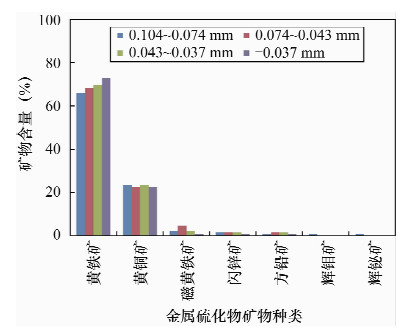
 下载:
下载:
